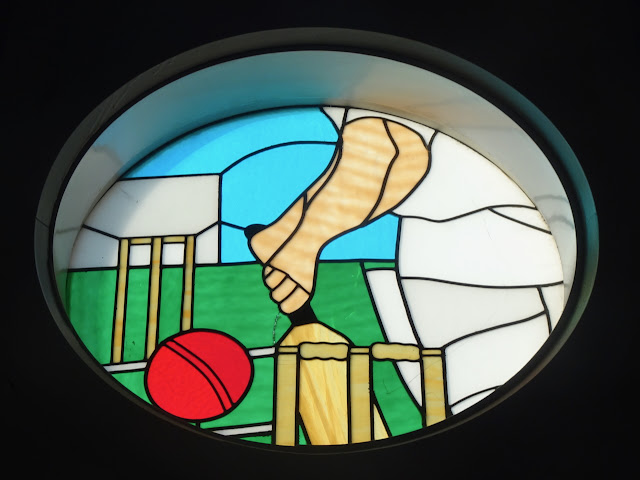Here is the 18th of 24 stained glass window designs on the Palace Pier which AI and I are using as inspiration for some of these BrightonBeach365 daily posts - see Stained Glass Window 1 for background. A lively soccer match is underway. In the foreground, a large black-and-white football dominates; to the right, the leg and foot of a player in blue shorts and striped socks is shown in motion, suggesting a kick. Behind the ball and player, a crowd of supporters fills the background, represented in bright blocks of colour - yellow, red, blue, green, and brown - with raised arms and cheering stances, creating the sense of excitement in a stadium atmosphere. The overall style is bold and simplified, with clear outlines and vivid colours.
A limerick starter
A striker with socks blue and white,
Kicked a ball with incredible might.
The crowd gave a roar,
As it sailed to the score,
And victory gleamed in the light.
The ball’s still in the air (with apologies to Nick Hornby)
I was standing on Brighton Beach, staring up at this stained-glass window in one of those seafront cafés, the kind that smells of chip fat even after it’s closed. It showed a football frozen in mid-flight, with a crowd behind it looking like they’d just seen God, or at least Peter Ward in his prime. The socks on the kicker were the clincher: blue and white hoops, the Seagulls’ stripes.
And suddenly I was back there, twelve years old, thinking Brighton & Hove Albion were going to change my life. Dad took me to the Goldstone Ground and I saw Gerry Ryan run down the wing like he’d been shot out of a cannon. That was it. I was hooked for good. But football - especially Brighton football - is like the sea here: it looks glorious when the sun’s on it, but most of the time it just drags you under and leaves you coughing up salt.
On the beach that morning, you could almost hear the echoes of promotion parties and relegation heartbreak. I’d been through them all, right down to the protests when we nearly lost the club. We stood outside with banners, shouting until our throats cracked, while inside men in suits plotted how to flog the ground for a Sainsbury’s. It felt hopeless. And yet here we still are, with a stadium on the edge of town, European nights, a place at the grown-ups’ table.
Looking back at that window, I realised why it hit me so hard. The crowd in the glass isn’t celebrating a goal. They’re waiting. The ball’s still in the air, and anything could happen: joy, despair, a dodgy referee’s whistle. It’s Brighton Beach in a nutshell. You sit on the shingle, you watch the horizon, and you think: maybe today the tide turns. Or maybe it just keeps rolling in and out, same as ever.
I finished my tea, wiped the crumbs from my lap, and thought about the next game. It’s ridiculous, really, this endless faith in a team, like waiting for a miracle on a beach that’s seen more storms than summers. But if you’re a Seagull, you don’t stop flying. You can’t.






.jpeg)

















